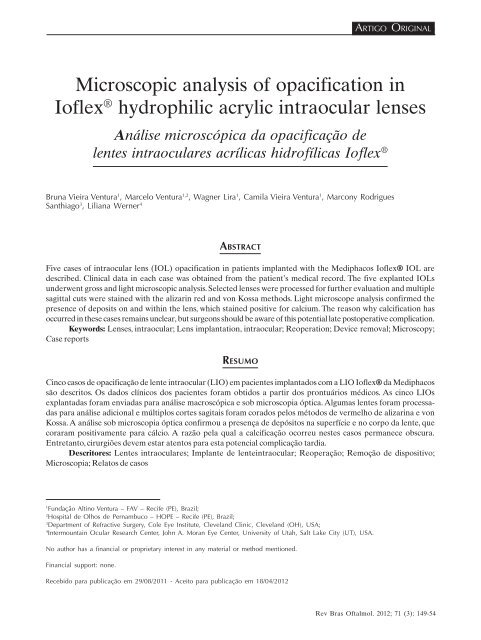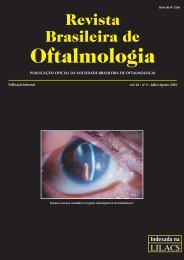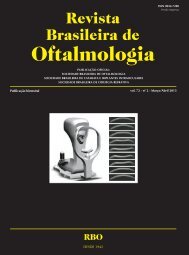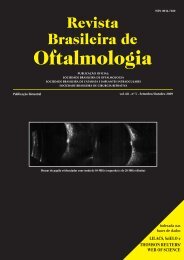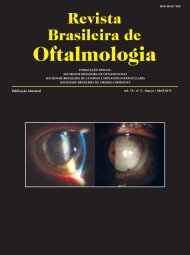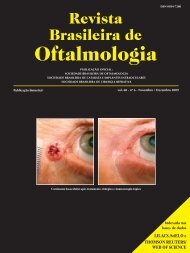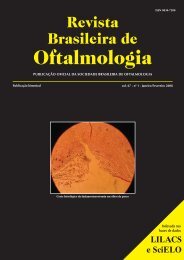Mai-Jun - Sociedade Brasileira de Oftalmologia
Mai-Jun - Sociedade Brasileira de Oftalmologia
Mai-Jun - Sociedade Brasileira de Oftalmologia
- No tags were found...
You also want an ePaper? Increase the reach of your titles
YUMPU automatically turns print PDFs into web optimized ePapers that Google loves.
ARTIGO ORIGINAL 149Microscopic analysis of opacification inIoflex ® hydrophilic acrylic intraocular lensesAnálise microscópica da opacificação <strong>de</strong>lentes intraoculares acrílicas hidrofílicas Ioflex ®Bruna Vieira Ventura 1 , Marcelo Ventura 1,2 , Wagner Lira 1 , Camila Vieira Ventura 1 , Marcony RodriguesSanthiago 3 , Liliana Werner 4ABSTRACTFive cases of intraocular lens (IOL) opacification in patients implanted with the Mediphacos Ioflex® IOL are<strong>de</strong>scribed. Clinical data in each case was obtained from the patient’s medical record. The five explanted IOLsun<strong>de</strong>rwent gross and light microscopic analysis. Selected lenses were processed for further evaluation and multiplesagittal cuts were stained with the alizarin red and von Kossa methods. Light microscope analysis confirmed thepresence of <strong>de</strong>posits on and within the lens, which stained positive for calcium. The reason why calcification hasoccurred in these cases remains unclear, but surgeons should be aware of this potential late postoperative complication.Keywords: Lenses, intraocular; Lens implantation, intraocular; Reoperation; Device removal; Microscopy;Case reportsRESUMOCinco casos <strong>de</strong> opacificação <strong>de</strong> lente intraocular (LIO) em pacientes implantados com a LIO Ioflex® da Mediphacossão <strong>de</strong>scritos. Os dados clínicos dos pacientes foram obtidos a partir dos prontuários médicos. As cinco LIOsexplantadas foram enviadas para análise macroscópica e sob microscopia óptica. Algumas lentes foram processadaspara análise adicional e múltiplos cortes sagitais foram corados pelos métodos <strong>de</strong> vermelho <strong>de</strong> alizarina e vonKossa. A análise sob microscopia óptica confirmou a presença <strong>de</strong> <strong>de</strong>pósitos na superfície e no corpo da lente, quecoraram positivamente para cálcio. A razão pela qual a calcificação ocorreu nestes casos permanece obscura.Entretanto, cirurgiões <strong>de</strong>vem estar atentos para esta potencial complicação tardia.Descritores: Lentes intraoculares; Implante <strong>de</strong> lenteintraocular; Reoperação; Remoção <strong>de</strong> dispositivo;Microscopia; Relatos <strong>de</strong> casos1Fundação Altino Ventura – FAV – Recife (PE), Brazil;2Hospital <strong>de</strong> Olhos <strong>de</strong> Pernambuco – HOPE – Recife (PE), Brazil;3Department of Refractive Surgery, Cole Eye Institute, Cleveland Clinic, Cleveland (OH), USA;4Intermountain Ocular Research Center, John A. Moran Eye Center, University of Utah, Salt Lake City (UT), USA.No author has a financial or proprietary interest in any material or method mentioned.Financial support: none.Recebido para publicação em 29/08/2011 - Aceito para publicação em 18/04/2012Rev Bras Oftalmol. 2012; 71 (3): 149-54


